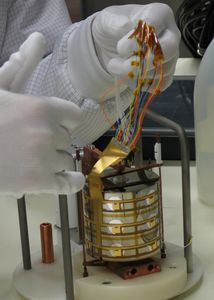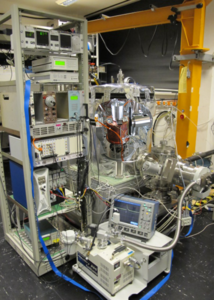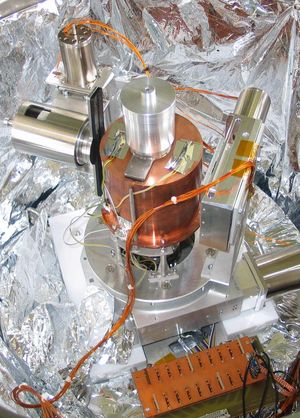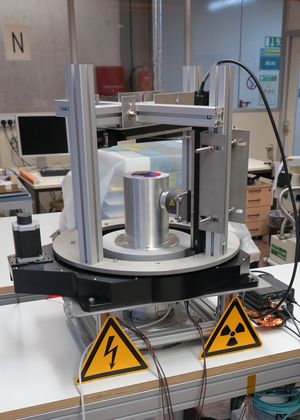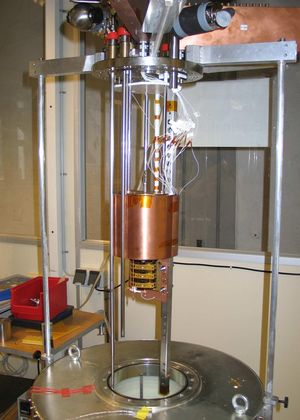Germanium detectors are not only used in the search for neutrinoless double-beta decay, but also in spectroscopy and in the search for dark matter. Results, which are obtained for detectors in one field are often interesting for the other fields.
There are other elements with isotopes that are candidates for neutrinoless double-beta decays, but germanium and its isotope 76Ge are attractive because the enrichment of germanium is well understood, the Q-value is relatively high and germanium is a semiconductor. Detectors made out of germanium are well known for their excellent energy resolution. Thus, germanium detectors can act as source and detector simultaneously, making them particularly efficient. The excellent energy resolution allows detailed spectral analyses which cannot be achieved with any other technology. This means that events from neutrinoless double-beta decay can be separated 100% from events from neutrino-accompanied double-beta decay.
A number of different types of detectors are used in the search for neutrinoless double-beta decay. Mostly, they are cylindrical and roughly the size of a coffee cup. The group operates two varieties of detectors, so-called true-coaxial detectors, which have a central bore hole penetrating the whole cylinder and so-called broad-energy detectors which do not have a bore hole but a small contact area on one end-plate of the cylinder. A specialty of the group is the usage of segmented germanium detectors, i.e. the detector mantle is divided up into several contact zones.
Germanium detectors can only at temperatures around 100 Kelvin (-173°C). The temperature dependence of the operation of germanium detectors is one research field of the group. This is connected to the mobility of the charge carriers in germanium. The effect of the crystal axes on the charge-carrier mobility is another research interest of the group.In addition, surface effects are studied, i.e. the response of the detectors to events close to the surface. Contamination with materials acting as alpha or beta sources produces events close to the surface, which can become difficult to identify background events. One way to identify such surface events as background events is to study the shape of the electric pulses generated by the detectors.Pulse shapes are also used to distinguish between events with one localised energy deposition (signal like) and events with multiple energy depositions (background). The study of the pulses in general and their simulation is also something the group focuses on. Segmented detectors provide unique opportunities to study the paths of charge carriers and there possible trapping. For this, pulses from segments in which no charge is collected, so-called mirror pulses, are used.
The group actively maintains three test stands, which all can be used to scan detectors. These test stands were designed with the experience gained from historical test stands.
The technical details and methods are described on special pages in English:
Further information on the GeDet group
Phone number: +49 89 32354-extension
| name | function | extension | office | |
|---|---|---|---|---|
| Abt, Iris, Dr. | Senior Scientist | isa | 295 | A.2.57 |
| Caldwell, Allen, Prof. Dr. | Director | caldwell | 529 | A.2.51 |
| Gooch, Christopher | Engineering | gooch | 242 | A.1.63 |
| Hagemann, Felix | PhD Student | hagemann | 327 | A.2.69 |
| Liu, Xiang, Ph.D. | Senior Scientist | xliu | 415 | A.1.65 |
| Schulz, Oliver, Dr. | Senior Scientist | oschulz | 521 | A.2.61 |
| Wacker, Ina | Secretary | ina | 207 | A.2.49 |
Characterisation of an n-type segmented BEGe detector.
I.Abt et al., Nucl. Instrum. Meth. A 925 (2019) 172-183
Alpha-event and surface characterisation in segmented true-coaxial HPGe detectors
Nucl. Instrum. Meth. A 858 (2017) 80-89
The GALATEA test-facility for high purity germanium detectors
Nucl.Instrum.Meth. A 782 (2015) 56
Measurement of the temperature dependence of pulse lengths in an n-type germanium detector
Eur. Phys. J. Appl. Phys. 56 (2011) 10104
Pulse shape simulation for segmented true-coaxial HPGe detectors
Eur. Phys. J. C 68, 609-618 (2010)
Neutron Interactions as Seen by A Segmented Germanium Detector
Eur. Phys. J. A 36, 139-149 (2008)
Characterization of the first true coaxial 18-fold segmented n-type prototype detector for the GERDA project Nucl.Instrum.Meth. A 577 (2007) 574
